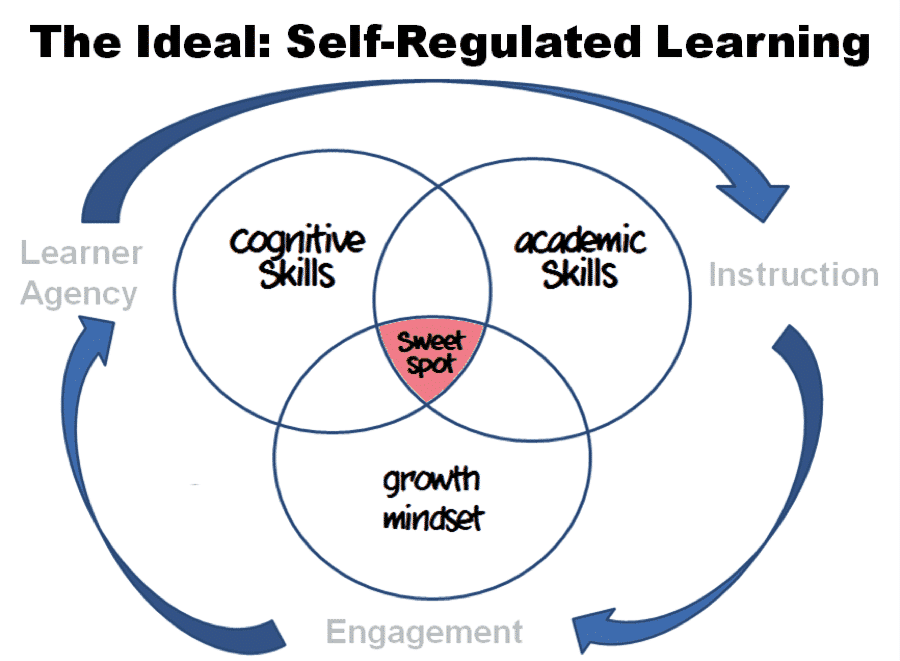By Nancy Weinstein
Part One of a Two-Part Series
Don’t let the latest “inconclusive” data on adaptive learning platforms, this time from the Gates Foundation/SRI at the college level, discourage you. Personalized learning is and will be effective. What the Gates Study might reinforce, however, is that implementing personalized learning is more complex than using a single adaptive technology for every learner and expecting universally positive outcomes.
That is not to say that adaptive learning technology platforms don’t work. There’s evidence that they do work. But the research reminds us that they are a tool, not the solution because they don’t work well for all students all the time. Based on the scientific evidence we have, we shouldn’t expect them to.
Cognitive assessments, such as the WISC, Stanford-Binet, and Woodcock-Johnson have been developed from over 100 years of undisputed research showing that there is broad variation in students’ cognitive abilities. Cognitive assessments identify how each student most efficiently receives, processes, analyzes and responds to information. In the classroom, teachers might observe the differences in how students remember, listen, reason, and focus. Layer on newer research on neuroplasticity about how cognitive capabilities change over time, and it should be no surprise that even the best-designed adaptive program wouldn’t work equally well for all students.
In contrast, personalized, or self-regulated, learning really can work well for almost all students almost all of the time. The term self-regulated learning might be preferable to personalized because it emphasizes the importance of students playing the central role in their learning. It is the student who must recognize when he is not learning effectively and ask for support.
It is the teacher who helps him adapt and adjust. Adapting and adjusting might involving using a different program, small group learning, or the myriad of different approaches teachers are already using in the classroom.
While student self-regulation might sound impractical in a world of helicopter parenting and disengaged learners, it can and does work. First, we know that when students take responsibility for their own learning, they are more intrinsically motivated leading to a virtuous cycle of continuous effort and improvement. Second, meta-studies evaluating the relative effectiveness of instructional strategies, show that self-regulation (metacognition, taking feedback, and self-monitoring) were shown to be more effective than any other pedagogy or intervention by a significant margin.
The reason self-regulated learning is so effective is that it has universal applicability, irrespective of ability or achievement. Unlike strategies such as spaced repetition which will have the greatest impact for students with weaker memory, or manipulatives for students who need more hands-on, visual representations, self-regulation works equally well for all students. Every student has relative strengths and needs, and every student benefits from taking feedback and learning how to improve, regardless of his starting point.
If the overwhelming body of research doesn’t convince you, practicality should. Quite simply, teachers do not have the time to personalize instruction for each and every student. While adaptive platforms have promise, keep in mind that all the achievement data in the world cannot accurately inform a teacher of who wants to learn more, who understands but can’t focus, and who could learn if it were just presented in a different way. Teachers NEED students to guide them.
The good news is that there are effective and straight-forward models we can use to teach self-regulated learning. One of our favorites is the framework developed at Carnegie Mellon (CMU). At its core, the CMU model assumes that students will show continuous improvement in learning if they can follow a three step process
- Identify goals
- Apply strategies
- Monitor and Adapt
Lather, rinse, repeat
The model in and of itself is practical and effective. The greatest challenge might lie in the identified pre-requisites to make it all work:
- Student’s beliefs about learning
- Motivation
- Knowledge of strengths and needs
Fortunately, significant progress has been made since the CMU research was published. We know a lot more about student beliefs about learning and motivation, in large part due to Carol Dweck’s seminal work on growth mindset. Dweck has shown the importance of growth rather than a fixed mindset.
She provides us with the language to use with students and the scientific evidence to support it. Her work also demonstrates the importance of intrinsic rewards over extrinsic motivators and the implications on outcomes.
There’s so much evidence supporting this work that a recent Education Week survey showed a near-universal 98 percent of teachers believe in the importance of fostering growth mindset. Though admittedly there is not yet the same success in implementation, we believe that fidelity to the CMU self-regulation model might lay the foundation for a virtuous self-fulfilling cycle for growth mindset as well.
Provided, that we can fulfill the third, and perhaps most complicated, pre-requisite, “knowing one’s strengths and weaknesses.” It’s complicated not because it is difficult, but because it requires overcoming embedded cultural barriers. In an age of “participation trophies acknowledgment,” there has been an increasing reluctance to acknowledge students’ weaknesses alongside their strengths.
Ironically, Dweck’s work might be in part responsible, though Dweck herself has spoken out about this misconception. She has explained that positive encouragement and reinforcement does not imply that we do not also offer balanced, constructive feedback. Quite simply, students cannot possibly be self-aware and identify how to improve acknowledgment of where they need help.
We need to create a culture where we openly acknowledge and accept that everyone has strengths, needs, and room for improvement. Even those students whom we might view as our most gifted learners have relative weaknesses that can be supported and improved upon to help them excel. Similarly, those we might consider to be struggling learners have relative strengths that should be nurtured as the foundation for building self-confidence and engagement. When we can openly embrace the idea that every student has unique strengths along with weaknesses, we create a learning environment where students feel safe seeking help, enjoy their successes and are motivated to continuously improve.

Once we feel comfortable openly identifying strengths and weaknesses, we need to think beyond the traditional measures of academic achievement. The other shortfall in adaptive learning platforms is that they fail to take into account skills beyond academic achievement.
We know that social-emotional and cognitive skills are key drivers in student learning, and it follows that these same skills need to be seriously considered in any self-regulated learning model. Fortunately, we can again turn to Dweck for support. Not only has she created her own program but her work has spurred others to develop new measures in helping evaluate students’ social-emotional strengths and needs.
Similarly, technology now affords us new opportunities to efficiently measure cognitive skills including executive functions, memory, reasoning skills, and processing speed, skills not easily observable or open to reliable self-report.
Despite the indisputable evidence on their accuracy and reliability, cognitive assessments have heretofore only been available to special education students because of the significant time and expense of administration, sometimes requiring over five hours of time with a trained professional. New standardized online batteries and questionnaires exist that accurately measure many of the underlying skills that drive learning in less than an hour at a cost similar to standardized achievement tests.
If we can combine newly available accurate and objective cognitive data and measures of student’s attitudes and beliefs about learning with our existing achievement data we have the foundation we need for instilling a self-regulated learning model that truly can be the basis for improved learning for each and every student.
In the second part of this series we will address how educators can integrate CMU’s 3- step self-regulated learning into any classroom.
Author
Nancy Weinstein is the Co-founder & CEO of Mindprint Learning, an educational technology company specializing in online cognitive assessments and personalized learning that is based in Princeton, NJ. Nancy has an MBA from Harvard Business School and BSE in Bioengineering from the University of Pennsylvania’s Management and Technology Program. Prior to Mindprint, Nancy held various roles in technology and finance at Goldman Sachs, The Walt Disney Company, and Bristol-Myers Squibb. She is the mother of two middle school girls.



